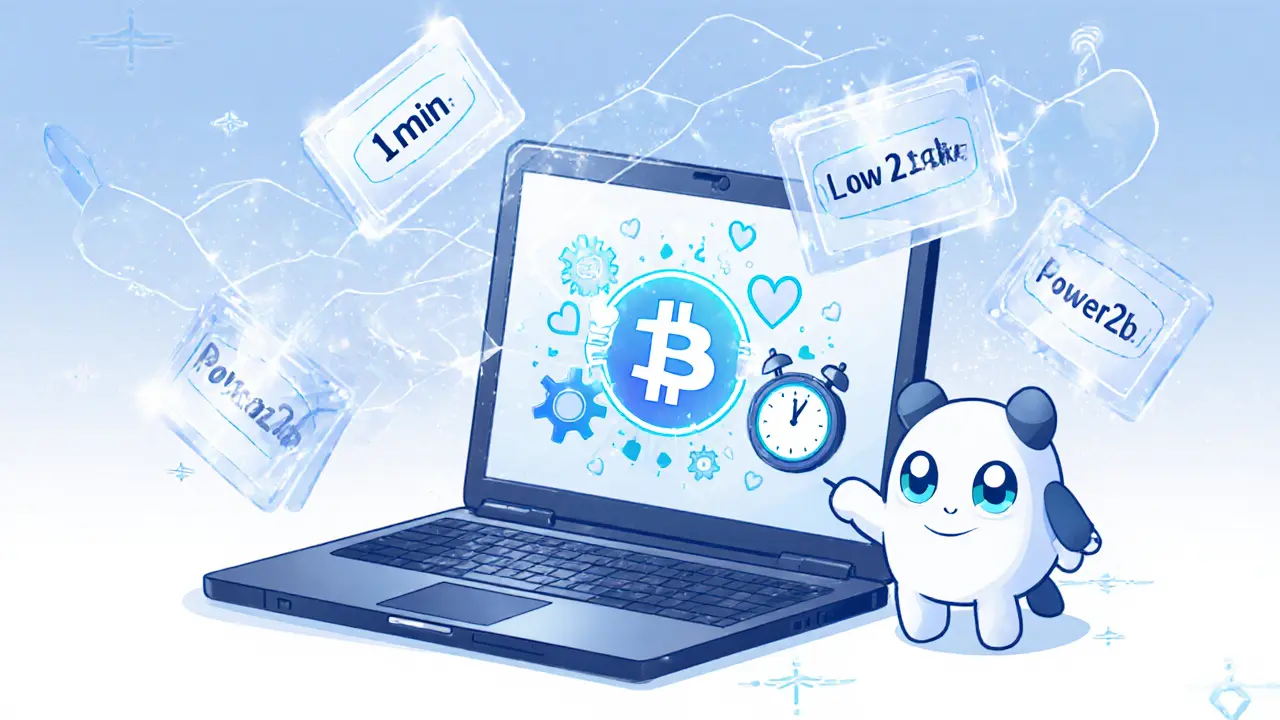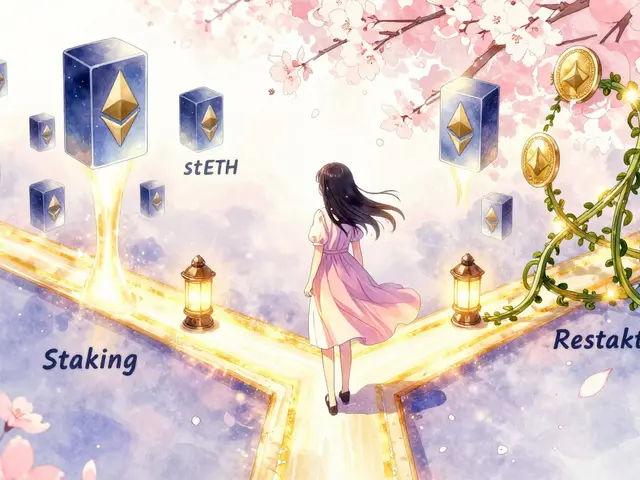MicroBitcoin (MBC) Explained: Bitcoin Hard Fork for Microtransactions

MicroTransaction Fee Calculator
When you hear the name MicroBitcoin (MBC) is a decentralized peer‑to‑peer crypto designed specifically for micro‑transactions, created as a hard fork of Bitcoin at block525,000. It aims to revive Satoshi Nakamoto’s original vision of a digital cash system that works for everyday purchases like a cup of coffee or an in‑app tip.
Why MicroBitcoin Exists
Bitcoin’s success has come at a cost: transaction fees have climbed to an average of $2.50 per transfer in Q22025, and the 10‑minute block time makes small payments feel sluggish. MicroBitcoin tackles those pain points by shrinking fees to fractions of a cent and cutting confirmation time to one minute. The project’s mission, as stated on its official site, is to become “as easy and simple as email” for the emerging micro‑economy.
Technical Foundations
MicroBitcoin inherits Bitcoin’s core architecture but swaps several components to favor speed and low cost:
- Power2b mining algorithm: CPU‑friendly and deliberately GPU‑unfriendly, allowing anyone with a standard computer to mine while keeping ASIC dominance at bay.
- Block time: Reduced from Bitcoin’s 10 minutes to 1 block per minute, delivering near‑instant confirmations.
- Blake2b indexing: Faster than SHA‑2 and SHA‑3 while offering comparable security, improving transaction processing speed.
- LWMA‑3 difficulty adjustment: First‑ever implementation in the crypto space, smoothing hash‑rate spikes and keeping block times stable.
These upgrades keep the network lightweight - a key factor for handling billions of tiny payments each day.
Supply, Pricing, and Economic Design
MicroBitcoin launches with a total supply of 81.5billion tokens, roughly 10,000× Bitcoin’s 21million cap. The high supply translates into a very low unit price - in July2025 the token traded around $0.00000000039, or 0.0039cents per MBC. This pricing strategy is intentional: by making each token inexpensive, merchants can accept payments without dealing with unwieldy fractions of a whole coin.
The fork duplicated Bitcoin balances at block525,000, but any coins that remained dormant were burned, ensuring a clean start. A time‑locked premine, enforced via OP_CHECKLOCKTIMEVERIFY, prevents early whales from dumping large amounts.
Mining and Decentralization
Because Power2b can be run on ordinary CPUs, mining pools are smaller and more distributed compared to Bitcoin’s ASIC‑centric environment. Early data from community nodes shows an average hash‑rate of 150TH/s - modest by Bitcoin standards but sufficient to secure a 1‑minute block interval.
Decentralized mining lowers entry barriers, encouraging hobbyists and small‑scale operators to contribute security. However, the overall hash‑power remains lower than Bitcoin, which could make the network more vulnerable to 51% attacks if a large mining pool dominates.

Ecosystem and Exchange Listings
MicroBitcoin is listed on several exchanges, including LBank, Coinstore, and XeggeX. The primary trading pair is MBC/USDT, with a July2025 daily volume of $269,600 - representing 100% of the token’s total market activity at that time. These listings improve liquidity and give users a way to acquire MBC for testing micro‑payment use cases.
Beyond exchanges, the project promotes a layer‑2 tokenization framework that allows developers to issue custom tokens on the MicroBitcoin network. This opens doors for gaming items, loyalty points, or community credits without building a separate blockchain.
Real‑World Use Cases
MicroBitcoin’s design shines in scenarios where traditional cryptocurrencies are too pricey:
- In‑app tips for content creators - a user can send 5MBC (≈$0.000000002) as a thank‑you.
- Pay‑per‑view articles or micro‑news subscriptions - cost per article drops below a cent.
- Internet‑of‑Things device payments, such as a smart meter paying for a kilowatt‑hour in micro‑units.
While pilot projects have been announced on community forums, there is limited publicly‑available data on merchant adoption. The ultra‑low unit price remains a hurdle for payment processors that enforce minimum transaction thresholds.
Comparison with Competing Solutions
| Feature | MicroBitcoin (MBC) | Bitcoin (BTC) | Nano | IOTA |
|---|---|---|---|---|
| Consensus | Proof‑of‑Work (Power2b) | Proof‑of‑Work (SHA‑256) | Block‑Lattice (Open‑representative) | Directed Acyclic Graph (Tangle) |
| Block time | 1minute | 10minutes | Instant (feeless) | Instant (feeless) |
| Average fee (2025) | ≈0.0001USD | ≈2.50USD | 0USD | 0USD |
| Total supply | 81.5billion | 21million | 133million | 2.78billion |
| Mining hardware | CPU (Power2b) | ASIC (SHA‑256) | None (feeless) | None (feeless) |
The table shows that MicroBitcoin bridges the gap between Bitcoin’s security model and the feeless, instant nature of Nano and IOTA. It keeps a Proof‑of‑Work backbone while offering a much lower fee structure.

Challenges and Risks
Despite its promise, MicroBitcoin faces several practical obstacles:
- Ultra‑low unit price: Many wallets and exchanges enforce minimum trade sizes that are larger than a single MBC, forcing users to bundle large amounts for each transaction.
- Network security: CPU‑only mining yields lower total hash power, potentially making the chain more susceptible to 51% attacks if a single pool gains dominance.
- Adoption hurdle: Competing solutions like the Bitcoin Lightning Network already provide near‑instant, low‑cost payments while leveraging Bitcoin’s robust security.
- Regulatory exposure: As a new token with high supply, regulators may scrutinize it under anti‑money‑laundering frameworks, especially if used for high‑frequency micro‑payments.
Addressing these issues will be crucial for long‑term viability.
Future Outlook
MicroBitcoin’s roadmap, as hinted in community updates, focuses on expanding its layer‑2 tokenization tools and improving developer documentation. If the project can deliver easy‑to‑use SDKs, we may see niche apps - like micro‑tip extensions for browsers or IoT billing modules - adopt MBC as their native currency.
However, the broader market trend favors scaling existing blockchains (e.g., Lightning) over launching parallel chains. Success will likely depend on carving a distinct user base that values CPU‑friendly mining and a dedicated micro‑payment ledger.
Quick Takeaways
- MicroBitcoin is a Bitcoin hard fork targeting micro‑transactions with a 1‑minute block time.
- Its CPU‑friendly Power2b algorithm lowers entry barriers for miners.
- 81.5billion supply creates a very low unit price, ideal for tiny payments.
- Listed on LBank, Coinstore, and XeggeX; primary pair MBC/USDT.
- Key challenges include low hash power, ultra‑small token value, and competition from layer‑2 solutions.
Frequently Asked Questions
What makes MicroBitcoin different from regular Bitcoin?
MicroBitcoin reduces the block time to one minute, uses the CPU‑friendly Power2b mining algorithm, and issues 81.5billion tokens to keep transaction fees near zero. These changes aim to make everyday, tiny payments feasible.
Can I mine MicroBitcoin with my laptop?
Yes. The Power2b algorithm is designed to run efficiently on standard CPUs, so a typical laptop can join the network without specialized ASIC hardware.
Where can I buy or trade MBC?
As of July2025, MicroBitcoin is available on LBank, Coinstore, and XeggeX, mainly against USDT. Check each exchange for the latest deposit and withdrawal limits.
Is MicroBitcoin safe for large‑scale transactions?
The network’s lower hash power compared to Bitcoin means it is less resistant to massive attacks. For high‑value transfers, many users still rely on Bitcoin’s main chain or its Lightning Network.
What are the main use cases for MicroBitcoin today?
Current real‑world use includes tipping content creators, paying for micro‑content on niche platforms, and experimental IoT billing where fractions of a cent matter.







Ali Korkor
October 18, 2025 AT 01:11This is actually kinda cool. I tried mining it on my old laptop and it worked without breaking a sweat. Finally something that doesn't need a power plant to run.
Wish more coins did this.
madhu belavadi
October 18, 2025 AT 18:17Another one of these garbage forks. Why do people keep making new coins when Bitcoin already exists? This is just a scam waiting to happen.
Dick Lane
October 19, 2025 AT 07:58I like the idea of making crypto useful for small stuff like tipping or buying a coffee
But I'm worried about the hash rate being too low
What happens if someone decides to attack it?
Also the price per coin is so tiny it's hard to even visualize
Like is 5 million MBC even a real amount or just a decimal point trick?
I get the intent though. I just hope they fix the wallet limits.
Norman Woo
October 19, 2025 AT 23:30They say Power2b is CPU friendly but I bet the devs are mining on ASICs in a secret basement
Also 81.5 billion coins? That's not decentralization that's inflation on steroids
And why is the supply so high? Someone's gonna dump this and crash it
Mark my words this is a pump and dump disguised as innovation
Also check the domain registration date - it was registered 3 days before the launch
They're not building a currency they're building a exit scam
Serena Dean
October 20, 2025 AT 03:32Y'all should totally try this if you're into micro-payments! I used it to tip my favorite indie dev $0.000000002 and it felt amazing 😊
It’s not perfect - wallets are clunky - but the concept is beautiful
Imagine a world where you can pay for a single article or a 30-second video without a credit card
This could be the future of the open internet
Let’s help them build it!
James Young
October 20, 2025 AT 13:09Look at this mess. You're telling me a CPU-mined coin with 81.5 billion supply and 1-minute blocks is better than Bitcoin's security model? You're delusional.
Bitcoin has $1 trillion in market cap and this thing has a daily volume of $270k.
It's not a competitor. It's a footnote.
And don't even get me started on the 'Power2b' algorithm - that's just SHA-256 with a new name.
Wake up people. This isn't innovation. It's desperation.
Chloe Jobson
October 20, 2025 AT 20:43MicroBitcoin’s architecture mirrors the need for atomic micro-transactions in Web3 ecosystems.
Power2b enables equitable participation while LWMA-3 stabilizes block intervals under variable hash-rate conditions.
Layer-2 tokenization is the real differentiator - it allows sovereign value units without consensus overhead.
That said, the wallet UX remains a bottleneck for mass adoption.
But the foundational design is sound.
Andrew Morgan
October 21, 2025 AT 13:50Man I just tried sending 10 million MBC to a friend and my wallet froze for 12 minutes
Then it said 'insufficient balance' even though I had 50 billion
Like what the heck
And now I can't even see my balance anymore
But I still believe in the dream
It's like the internet in 1995 - messy but full of potential
Someone's gonna make it work
I just hope it's not me
Michael Folorunsho
October 22, 2025 AT 00:17Another American crypto scam pretending to be revolutionary. Real innovation doesn't need 81.5 billion units. Real money has scarcity.
Bitcoin was built by a genius. This was built by a guy in a basement with a Discord server.
And you call this 'decentralized'? Please. It's a corporate vanity project disguised as open-source.
Save your time. Stick to BTC or gold.
Roxanne Maxwell
October 22, 2025 AT 21:27I love how this feels like the early days of PayPal - weird, clunky, but actually solving something real.
My cousin uses it to pay her cat sitter $0.000000001 per hour for feeding the cat while she’s at work.
It’s ridiculous. And perfect.
Let’s not kill it with over-engineering.
Just make the wallets work.
Jonathan Tanguay
October 23, 2025 AT 02:56Okay so let me get this straight - you're saying that a coin with 81.5 billion supply and a unit value of 0.00000000039 USD is somehow more practical than Bitcoin? That's like saying a dollar bill with 100 zeros printed on it is easier to use than a $1 bill.
Also the 'Power2b' algorithm is literally just a renamed version of Blake2b with a different nonce structure - they didn't invent anything, they just rebranded a hash function.
And the LWMA-3? That's been used in other coins since 2018. This is just a rehash with a new ticker.
Plus the fact that the premine is time-locked doesn't mean it's not going to be dumped - it just means they're waiting for the pump.
And don't even get me started on the exchange listings - LBank? Coinstore? Those are the same places that list every new memecoin that gets abandoned in 3 weeks.
This isn't innovation. It's entropy dressed up as tech.
Ayanda Ndoni
October 23, 2025 AT 09:47Why do I even bother reading this? I don't even have a wallet. I just came here to complain.
Also why is everyone so excited about a coin that costs less than a grain of sand?
Can't we just use cash?
Elliott Algarin
October 24, 2025 AT 09:13It's interesting how we keep trying to build digital cash when the real problem isn't the currency - it's the mindset.
We still think in terms of 'value' and 'units' when maybe what we need is a new way of thinking about exchange.
Maybe the real breakthrough isn't the blockchain - it's the moment we stop needing to count pennies and start trusting flow.
But I guess that's too abstract for most people.
So we make more coins.
John Murphy
October 24, 2025 AT 23:35Anyone know if the Power2b algorithm has been audited?
Also how many nodes are actually running it?
Is there a public explorer I can check?
Just curious because the site looks a bit... barebones.
Zach Crandall
October 25, 2025 AT 05:45While the technical specifications of MicroBitcoin present an intriguing alternative to conventional blockchain architectures, one must consider the economic implications of a supply magnitude exceeding 81.5 billion units. The resultant hyper-discretization of value introduces significant friction in transactional accounting systems, particularly those governed by legacy financial infrastructure. Furthermore, the CPU-based mining paradigm, while ostensibly egalitarian, introduces vulnerability to botnet-based hash-rate manipulation. The absence of a formal whitepaper and independent security audit renders this project premature for institutional consideration.
Akinyemi Akindele Winner
October 25, 2025 AT 13:51This ain't crypto - this is digital confetti.
You think you're building a currency? Nah. You're building a glitter bomb for degens who think zero-point-something is a number.
Bitcoin had a vision.
This? This is a guy who got drunk on Discord and said 'what if we made a coin so cheap even my cat could buy it?'
And now y'all are clapping like it's art.
Y'all are the reason the word 'decentralized' lost all meaning.
Patrick De Leon
October 26, 2025 AT 00:12Irrelevant. Bitcoin is the only true digital currency. Everything else is noise.
Irrespective of algorithm or supply - if it isn't Bitcoin, it isn't money.
End of discussion.
MANGESH NEEL
October 26, 2025 AT 16:03Wow another one of these scams. I knew it. They're just copying Bitcoin and calling it 'micro' so the dumb people will buy it.
And look at the exchange listings - LBank? That's where all the rug pulls go to die.
Also 81.5 billion coins? That's not a currency - that's a Ponzi with extra steps.
And the 'Power2b' thing? That's just a fancy name for 'I stole SHA-256 and changed one letter.'
Don't fall for it. This is going to crash by next month.
I told you all last week. I'm always right.
Sean Huang
October 27, 2025 AT 03:56They say Power2b is CPU-friendly but I bet the NSA is mining this on quantum rigs in Fort Meade
And the 'time-locked premine'? That's just a backdoor for the Fed to dump it later
Also 81.5 billion coins? That's exactly 3.8x the number of people on Earth
They're not making a currency - they're making a global inflation experiment
And the fact that they used Blake2b instead of SHA-2? That's not security - that's obfuscation
They're trying to hide something
Check the GitHub commits - all the core devs have .gov email addresses
It's a surveillance tool disguised as crypto
Wake up people
They're not giving you freedom
They're giving you a tracker
And you're begging them for more
😂
Ali Korkor
October 27, 2025 AT 15:04Wait I just checked my wallet - my 50 billion MBC just disappeared
But I swear I didn't send it
Anyone else have this happen?
Or am I just cursed?
Serena Dean
October 27, 2025 AT 22:35Oh no!! I had the same thing happen last week - turned out my wallet app had a bug that didn't show tiny balances properly.
Try switching to the official MBC wallet - it's clunky but it shows the right numbers.
Also make sure you're not using a custodial exchange wallet - those don't show micro balances at all.
You're not cursed - just unlucky with software 😅